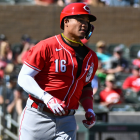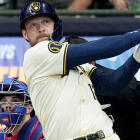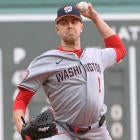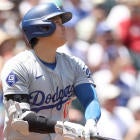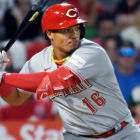Last spring, I asked for our readers to send us some of the quirky rules they have implemented in their leagues.
You responded. You responded in force.
We had to hire nine interns, four accountants and two massage therapists (had a kink in my neck) to filter through all of the responses -- and it took them over a year to get it done.
Some of you sent in what ended up being "normal" rules. Thanks for making me read them. I'll never get that part of my life back. Then, some of you sent me 14-page reports making up your league constitution. If you are too lazy to edit it down for the quirky parts, why would you expect me to be any less lazy? I rewarded those e-mails with the ol' SHIFT and DELETE buttons.
Some of the common themes sent included multiple weekly matchups in Head-to-Head leagues, to make the league standings more like a 162-game schedule.
Also, nearly every e-mail included the words, "Here is why our league is the best." Although "best" was sometimes replaced by "ultimate," "greatest" or "most competitive." Either way, it's safe to say you liked your system and don't plan on changing it anytime soon.
In case you and your fellow owners are interested in trying something different, here are the some of the best suggestions. If you don't want to change your league, at least consider starting an alternate league by using some of these ideas.
Sometimes different is better
Michael Clark, Pray for Rain League: We have found that having a partial keeper league is best. It permits owners to retain players they like and also permits all teams to draft different superstars. ... We have 20 position players and 15 pitchers which we draft separately (two different drafts). ... We have three 5-year contract players; three 4-year contract players; three 3-year contract players; three 2-year contract players and 12 one-year contract players. At the end of a season the twelve (1) year contract players all become free agents for the next year's draft. ... After we draft the eight new players we award three 5-year contracts and the other five players get 1-year contracts. We continue this year to year which always releases players back into the free-agent pool. ... We have a total score at the end of the season to determine standings, but some of us also do Head-to-Head on the side. ... We have continued this format for about 15 years.
Gerry Nason, Saratoga Springs, N.Y.: Probably the biggest difference between us and other leagues who "claim to be realistic" is the fact that we employ a "free trading system." In 15 years of Fantasy play, I could never understand why so many leagues were content to use a system of allowing your competitors to say if your trade should be allowed to pass or not. DUH!!! These people are trying to beat you! How many of them honestly want their competitors to get better? The Orioles do not have to ask the Yankees if it is okay if they make a trade with the Red Sox. Why should we do this in Fantasy leagues?
D.G.: I couldn't agree with you more. My response to owners in my league that freak out about a trade is that they should have gotten to the mark first. Now if it's obvious that there is collusion, that's a different story. But in leagues where you are all familiar with each other, trade vetoing is unnecessary in my opinion.
Clay Fees, Kellyville, Oklahoma: We give five points for a quality start (this keeps the Ben Sheets and Zach Dukes of the world from being punished for having bad offenses behind them). We also use a Tier system for keepers. We keep 12 each year, and we designate nine of those as Tier 1 keepers, then the remainders are Tier 2s. The first six picks of our general draft are Tier 2s and the remainder and all free agents automatically get Tier 3 status. When you trade, the tiers must add up for the trade to be approved: A Tier 1 keeper is worth two Tier 2s or 4 Tier 3s. This keeps trades balanced and eliminates any arbitrariness on the part of the commissioner or owners in approving trades. If it adds up, it is approved. Draft picks can be thrown in there to make it balanced as well. ... We also have an all-star game of players voted on by our owners based on scoring stats only. Along with this, each team nominates one player for the home run derby and strikeout competition, which is determined by their stats that week.... And, yes, we have way too much time on our hands.
D.G.: Well done, Clay. I love the creativity with the tier system. As far as your all-star game idea, that's great as well! In the early '90s, we used to do an all-star game for our Fantasy Football league on the first week after all the byes. Each of the three divisions fielded a team with its best players to that point for a three-way Head-to-Head game. The teams from the division that won the game received a bonus 25 points in their Points For column for the season, which was also the tiebreaker after Head-to-Head. It was the only time I actually rooted for players from the other teams in my division!
David S. Cohen, Philadelphia: For 13 or 14 years now, our NL-only 5x5 Rotisserie league has allowed each team to have one AL hitter to fill any roster spot. We started it in the early '90s when there was some great young AL talent that we NL-followers were ignoring. Now, as the league lines in real life have blurred, the rule is just a remnant from the past that most of us enjoy anyway. It makes for some interesting bids and strategy on auction day -- Alex Rodriguez for $8, Manny Ramirez for only $4 and David Ortiz for $2.
Scott Horsman, Kansas City: Our league is a 12-team, seven-keeper, 6x6 Head-to-Head league in which the most category wins gets the win. Batting categories are BA, SB, RBI, HR, runs scored and walks. Pitching categories include ERA, WHIP, W, K, S and innings pitched. OPS is so similar to BA that we decided to use BB instead. We decided to use IP to emphasize starting pitching. Seven keepers was our hot topic -- having more keepers will hopefully encourage trades.
David Scutt, Popes of Baseball: I wouldn't classify our league as "quirky", but there's no question that we're unique in Fantasy Baseball. The league is known as "The Popes of Baseball" because reading the box scores has become a religious experience. We started the league in 1988 with seven teams, it has grown to 14. We use mixed-league teams and each team has 25 players, all of whose stats count. No "reserve" players are allowed, but you may substitute for DL'd players. ... We use 21 categories, 12 hitting and nine pitching. The categories are weighted so that major categories like ERA, HR, BA count more than minor categories like CG, 3B, and NSB. But every category counts! It truly makes you value a player similar to the way a major league team would -- you have to look at the overall worth, and not just if he can do one or two things well. ... Thanks for taking time to hear about our experiences, what I've touched on here is just a sample of what we consider the most successful of Fantasy Baseball. The CBS site has been a wonderful enhancement and taken the league to even greater heights than manually doing all the numbers.
Chris Carlson: Our league is called The Greatest League in the Land, for reasons that should soon become evident. ... Every player is allowed to keep three players every year along with one rookie per year (on three-year rookie contracts). For instance, my team started the season with Derrek Lee, Bobby Abreu, Carlos Beltran, Justin Morneau (2004 rookie) and Huston Street (2005 rookie). In previous seasons, clever teams have found loopholes in the rules. Rotating through four starters a day, along with four stud closers, was often enough to win three of the five pitching categories. This year we added losses and OPS (as well as a 30 innings-per-week minimum) in an effort to curb the spot-starter and speed-heavy strategies that had already been proven to work in the playoffs. ... We trust each other to the point where we trade draft picks, rookie-contracts and eligibility and are even allowed to trade future considerations.
Bobby Lindsay: We decided to implement a salary cap using the player's real salaries according to USA Today's baseball salaries database. We use the prior year's salaries because as you will see they are the most accurate. We have $110M salary cap to draft a team of 26 players. ... If a team goes over the salary cap, they are fined. The fines act as a luxury tax that will be dispersed between the other 11 teams. My league is the most realistic Fantasy league I have ever been a part of. Using the real salaries, luxury tax, and three-man executive board to review and approve trades I feel this league is a far superior to any other league.
D.G.: Very interesting, Bobby. This is sort of set up like a challenge game, where you pick a player from Group A, Group B, Group C and so on, but I love the fact you were able to take advantage of some cheap studs last year like Miguel Cabrera ($370,000) and Travis Hafner ($377,400).
Eric Porter, Portland, Ore.: We have a keeper system I have not seen before. It brings a salary cap feel to a draft league. Players are assigned point values based on the round they were most recently drafted in: 22 points for a first-round selection, down to one point for a 22nd rounder or a free-agent pick up. Players hold their keeper point value if traded, but become one pointers if dropped and then picked up by another team. Each team can keep 40 points worth of keepers and you give up the picks in the draft that correspond to the players you keep.
Jonathan Rains, Sacramento: Truthfully I've never heard of any twist like this before (perhaps I'm just sheltered). The challenge lies not in an eccentric scoring system, but in that each active roster must keep a player from every team in the majors in the scoring lineup to maintain a legal weekly lineup. The intent is to prevent any team from loading up on players from the usual high scoring offenses and forcing owners to strategize not only positional scarcity, but also relative value of each player on every MLB team. Therefore, each of the 10 teams could have one each of 1B, 2B, 3B, SS, CI, MI, two Cs, seven OFs, three Utility players, nine SPs and three RPs. The proportion of offense to pitching remains about the same as most Fantasy leagues, and in spite of the increased roster sizes, there are still plenty of free agents available (for creative managers) since both AL and NL would be used. Roster shuffling and trading would be highly creative around the MLB trade deadline, too. ... P.S. I love your column!
D.G.: This is a nice little twist. I saw a couple that touched on something like this, but this has merit -- and it makes mixed leagues a little more challenging. The larger rosters force different strategies from regular leagues as well. P.S. I love your idea!
Steve Garth: The Ormond 8 League uses several non-standard ways to truly be unique. But the most unusual thing we do is have a "blind" first round of our auction, where each team submits a written bid sheet on players for each position. The highest bidder gets the player. We then fill our rosters using a typical auction format. We find this allows owners to steal players -- a $1 bid on a superstar is enough if no one else bids -- and then they'll have a big advantage heading into the full auction. Or an owner can get outbid for every player in the blind bid and have a huge job to fill in the auction.
D.G.: This has to be one of my favorite ideas for auctions. Just another thing to make you strategize even more. Awesome! Again, this changes the views on normal dollar values for all players, but as an extra league, I like this concept.
Jeff Blundell, Toronto, Upper Canada Fantasy Baseball League: To make sure that big name players get moved around we introduced "free agency" to our keeper pool. Each of the 16 teams gets to protect six players. But at the draft, each manager rolls a single die. Whatever number you roll, that player leaves your team and enters the available player pool. This year, if I roll a #1, it's bye-bye A-Rod.
D.G.: I can hear it now, "Come on, Papa needs to keep his 30-30 man!" Interesting way to get stars back in the draft. As long as your owners don't bail after losing a superstar, I like how your team is further tickled by the fickle fingers of fate.
Michael Walton, Stevensville, Md.: We have a few interesting wrinkles in an otherwise straight-forward 12-team NL-only auction-style league. We have a minor league draft, diamond-shaped keeper structure, an interesting waiver-claim structure, and my personal favorite -- compensatory minor league draft picks for players with certain stats that get traded to the AL in the off-season.
Darrin Quinn, San Jose: In my league, "West Coast Players," there are only six teams. We've had requests from other friends wanting to join, but with our rules it's very difficult to have more than six teams. We play both Head-To-Head and Rotisserie. At the draft we each draw a league (Ale and Stout), then we draw for drafting place and then the Team to draft from. In our league you are only allowed one player from each major league team. The only time you can have more than one player from a team is if that player was traded after the draft. Whenever you want to drop a player, you must pick-up a player from the same team in which the player you dropped.
Dave Voight, Los Angeles: Here's a killer idea that I started in a Fantasy Football league, but still works great for baseball. In my 10-team Head-to-Head league, we have adopted a "toilet bowl" playoff system. The top four teams make the big boy playoffs and the bottom six go into the toilet bowl. The best two teams of the bottom six get a bye the first week and basically the toilet bowl bracket is set up just like an NFL playoff bracket. The prize money for the toilet bowl title is usually about 3/4 of the entry fee. I have found that this keeps the bad teams interested all year ... And if you're "lucky" enough to win the toilet bowl, you can chant with pride "I'm No. 5! I'm No. 5!" Or just shut your piehole and be glad you didn't lose all of your money.
Julian Tan, The XLB: Our league has morphed considerably over time, and we've finally taken the plunge into Head-to-Head this year. However, we continue to have many quirks in our 20 category points-based scoring system. For example, we award points for defense: two points for an outfield assist, two points for a catcher throwing out a runner, and half a point for a middle infielder turning a double play. Relievers also get some different stats, including five points for a hold (vs 7 for a save) and -2 for allowing an inherited runner to score, as well as earning three points per IP (vs 2 pts per IP for starters).
Chris Wood, San Diego: By far, the quirkiest thing we do -- and the most popular thing we do -- is have a half-way draft. We play a basic 5x5 NL-only league, with no keepers from year to year. At the all-star break, we each are allowed eight keepers for the same salary that we originally paid, all of the rest of the players go back into the draft. You still have the same $260 to draft your team at the halfway point, minus the amount you have allocated for your keepers. Stats are all cumulative, but the leading team can really screw things up, so it keeps everyone interested. We have had a team come from last place at the break to be the overall champion. We figured drafting is the most fun part of Fantasy Baseball, so why not do it twice? We do allocate 10% of the total pool to winning the 1st half, so at least you get something for it.
Ed Burnett: Our keeper league is a little different. In our league, each team is given three keeper rights at the beginning of the season. During the season these keeper rights can be traded, which makes end-of-the-season dealings a lot more interesting. Who is going to go for the championship and who is going to build for the future?
Del LeFevre: My league format for '05 was the "Two Tiers of Terror" -- a Head-to-Head Rotisserie league, with the most category wins as the determining factor for the matchup. However the twist was categories were weighted differently. The "Two Tiers" of weighting are as follows:
- One-point categories -- Hitting: CS, KS, singles, doubles, triples and bb. Pitching: Holds, BAA, K/9, BS, QS, CG and SHO.
- Two-point categories -- Hitting: BA, OBP, SB, HR, RBI and runs scored. Pitching: W, L, SV, ERA, WHIP and Ks.
We use the "Two Tiers of Terror" for a few reasons. One, fun alliteration. Two, it allows for tracking hard-core stat geeks favorite categories like K/9, BAA and QS. And three, it includes marginal stats (Triples, holds, etc.), but lessens their impact.
James Sapia, Spring Hill, Fla.: We've used an unorthodox scoring system for the past few years that combines similar stats and has proven to be well-rounded without going overboard. We go Head-to-Head in five hitting and five pitching categories, with each category counting as a win in the standings. That means, in effect, we play 10 games per week. Hitting categories include: BA, 1B+BB (singles plus walks -- the Barry Bonds category), 2B+3B+SB (doubles plus triples plus stolen bases -- helps those that shoot the gaps), HR, and finally, RBI+R (RBI plus runs scored -- puts leadoff speedsters on equal footing with mashers). Pitching categories include: W+QS, Ks, Saves, ERA and WHIP.
D.G.: A lot of leagues are trying to get their final standings to look a little more like the 162-game schedule that MLB uses. This is one way, although, the final standings will equal upwards of 200 games, rather than 162. Great idea though! Some leagues use multiple matchups with different teams. For instance, if you have 12 teams in your league with a 22-week regular season, you can have teams play multiple games weekly against multiple different opponents. It's a scheduling nightmare for your commissioner, but it would get you a more realistic set of standings.
Justin Jasionowski, Chicago: My league is a mixed Head-to-Head league with a fairly standard scoring system, except we also added in Team Defenses to the scoring system. The points are as follows: errors (-2 pts), double-plays (1), pickoffs (2), caught stealing (1), OF assist (1). I've always been a defensive-minded guy so I thought it would add an interesting little twist to our Fantasy season.
Kevin G. Chapman: Our league is better -- not just different. We've been in business since 1989 (back when we did the stats by hand). We've tried to make the value of players more akin to their value in "real" baseball, which includes using eight categories for hitters, and five for pitchers -- to avoid over-valuing closers or pitchers in general as opposed to good hitters. We include walks (actually, walks minus strikeouts), as well as doubles and triples so that gap hitters are not overlooked for a 30 HR-150 K man (can you say Dave Kingman?). We also use net wins (wins minus losses), so the 10-10 guy is a zero, and the 8-1 reliever scores seven. We require each pitching staff to have five starters, one closer, one middle man, and one "wild card". Thus, you have to have a "staff" that is like a real staff.
We draft 40 players, and there is no free agency. You go with your 40 men (although, we have a mid-season supplemental draft where owners can cast off the dead wood and draft available free agents).
Devin, Westchester Legion: Since I'm supposed to be writing a research paper, I thought I'd procrastinate and share some of the more interesting rules my league uses. ... We use a snake draft with hitters and pitchers drafted separately. While there have been arguments that this reduces the complexity, we feel that it also makes it fairer. We arrange the draft so that whoever has the first hitter pick gets the last pitcher pick and vice versa.
In our scoring system, every at bat is (-2) points. This means that simply having a player in the game is not necessarily a good thing. A batter than goes 0-for-4 with two strikeouts will wind up with (-10) points for the day (as a point of reference, a good weekly team score is around 300 points). However, a single will net the hitter three points (2 for the single, (-2) for the AB and 3 for the hit). This means that hitters need to be productive. We also value quality starts more than wins and that an earned run negates two innings ... In the long run we all feel it gives a much more accurate assessment of pitcher performance and balances the nine pitchers nicely with the 14 hitters. Plus it has added the phrase "did he get the quality" to all of our speech.
I hope that you actually read this far down. At the very least, this was 45 minutes I didn't have to think about Frederick Jackson Turner's frontier thesis. Thanks for that.
D.G.: I edited out a lot of the scoring notes in this email, mostly because it was covered by other readers. But I hope Devin didn't mix notes and end up calling Frederick Jackson Turner one of the best second basemen in the NL.
Andy Schwartz, Elmwood Park, N.J., The Big Boys League: We run our draft auction style and use a $280 cap. When a player is won at auction the team owner has the chance to sign the player for 1, 2 or 3 seasons. The catch is that the contracts are mostly guaranteed. If the player is ever cut, the team is still responsible for paying half of their contract, rounded up to the nearest dollar. Players on the DL only incur a one-quarter penalty to give the team a bit of a break. And any team that picks the player up off the free agent wire after that only has to pay the remainder of their salary. Undrafted free agents all cost $1 and can also get up to a three-season contract. Many trades in our league involve the exchange of salary cap money and sometimes teams even pay a part of a player's contract to help get rid of him, just like in real baseball. Right before the trade deadline there tends to be a bunch of big name players in their final contract year that get traded for prospects or cap money in future seasons, so a bad team one year can make some smart trades and come back strong the next..
Have a comment or a Quirky League of your own for the Fantasy Baseball writers? Feel free to email me at DMFantasyBaseball@cbs.com. But make sure you add "Attn: Quirky Leagues" so that Emack knows to ignore these e-mails instantly! I might not be able to answer all questions due to a large volume, but I'll do my best.








